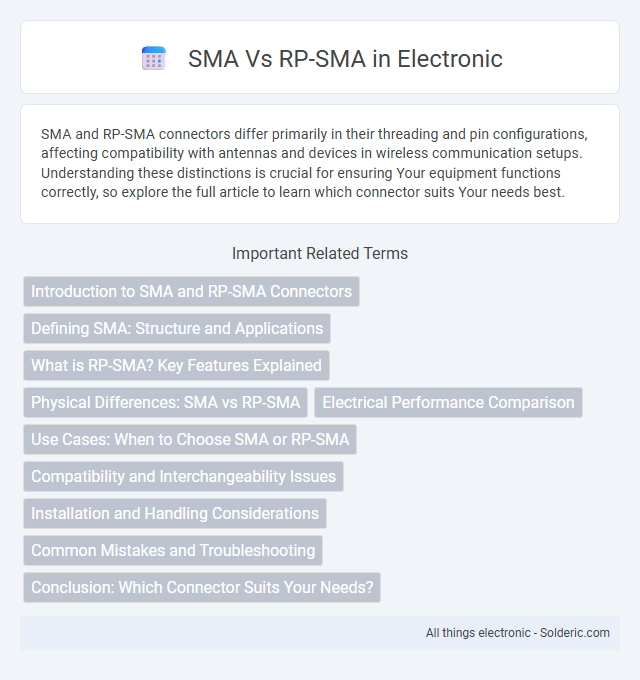SMA and RP-SMA connectors differ primarily in their threading and pin configurations, affecting compatibility with antennas and devices in wireless communication setups. Understanding these distinctions is crucial for ensuring Your equipment functions correctly, so explore the full article to learn which connector suits Your needs best.
Comparison Table
| Feature | SMA Connector | RP-SMA Connector |
|---|---|---|
| Full Form | SubMiniature version A | Reverse Polarity SubMiniature version A |
| Gender | Male connector: Pin center | Male connector: Socket center |
| Thread | External threads on male | Internal threads on male |
| Usage | Standard RF antenna connections | Wi-Fi and wireless device antenna connections |
| Frequency Range | DC to 18 GHz | DC to 6 GHz |
| Applications | Telecommunications, test equipment | Wi-Fi routers, wireless cards |
| Compatibility | Not compatible with RP-SMA | Not compatible with SMA |
Introduction to SMA and RP-SMA Connectors
SMA and RP-SMA connectors are precision RF coaxial connectors widely used in wireless communication systems, offering reliable signal transmission up to 18 GHz for SMA and around 6 GHz for RP-SMA. SMA connectors feature a threaded interface with a center pin, while RP-SMA connectors reverse the gender of the center pin and socket, preventing accidental mating with standard SMA connectors. Understanding these differences ensures your wireless devices and antennas connect correctly for optimal performance.
Defining SMA: Structure and Applications
SMA (SubMiniature version A) connectors feature a threaded interface and are widely used for microwave systems, antennas, and RF applications requiring reliable high-frequency signal transmission up to 18 GHz. Their compact design with a 1/4 inch hex nut ensures secure connections in telecommunications, test equipment, and GPS devices. SMA connectors provide excellent performance in demanding environments, making them ideal for coaxial cable terminations in wireless communication and RF modules.
What is RP-SMA? Key Features Explained
RP-SMA (Reverse Polarity SMA) is a type of connector designed to prevent accidental mismating by reversing the gender of the interface contacts compared to standard SMA connectors. Key features include a threaded barrel for secure screw-on connection, reverse polarity design where the male RP-SMA has a female center pin and the female RP-SMA has a male center pin, enhancing compatibility with specific wireless devices such as Wi-Fi antennas. RP-SMA connectors are widely used in applications requiring reliable RF connections with controlled polarization, ensuring proper device interfacing and signal integrity.
Physical Differences: SMA vs RP-SMA
SMA connectors feature a threaded male pin that protrudes from the center, while RP-SMA connectors reverse this design with a female center pin inside the male-threaded housing, ensuring compatibility only with corresponding RP-SMA devices. The physical key difference lies in the gender of the center conductor, impacting how the connectors mate and preventing cross-connection with standard SMA cables. Your choice between SMA and RP-SMA must consider these distinct physical characteristics to ensure proper antenna or RF device connectivity.
Electrical Performance Comparison
RP-SMA connectors provide better electrical performance than standard SMA connectors by offering lower signal loss and improved return loss, making them ideal for high-frequency applications up to 6 GHz. The precision in RP-SMA's center pin design reduces impedance mismatch, enhancing signal integrity in wireless communication systems. When optimizing Your RF systems, choosing RP-SMA ensures more stable transmission with minimal insertion loss compared to SMA connectors.
Use Cases: When to Choose SMA or RP-SMA
SMA connectors are ideal for applications requiring a male pin connection, such as antennas and RF modules in wireless communication systems. RP-SMA connectors, featuring a reversed gender interface, are commonly used in Wi-Fi devices and routers to prevent incorrect antenna installation. You should choose SMA for standard RF signal transmission and RP-SMA when compatibility with specific consumer wireless equipment is required.
Compatibility and Interchangeability Issues
SMA and RP-SMA connectors differ primarily in their pin configurations, which affects compatibility and interchangeability; SMA connectors have a center pin, while RP-SMA connectors have a center socket, making them incompatible for direct mating without adapters. Your devices with RP-SMA ports require matching RP-SMA plugs to ensure proper connection and signal integrity. Using incompatible connectors risks damaging antenna ports and degrading performance, so verifying connector type is essential when upgrading or replacing RF components.
Installation and Handling Considerations
SMA and RP-SMA connectors differ significantly in installation and handling, with SMA connectors featuring a threaded interface that ensures secure, vibration-resistant connections ideal for high-frequency applications. RP-SMA connectors have a reversed-polarity design, which requires careful alignment to avoid damaging the delicate internal pin or socket during installation. To maintain optimal performance and prolong the lifespan of Your RF equipment, handle each connector type with appropriate torque and avoid cross-threading during assembly.
Common Mistakes and Troubleshooting
Common mistakes when working with SMA and RP-SMA connectors include mixing the two types due to their similar appearance but different pin configurations--SMA has a center pin, whereas RP-SMA has a reversed pin. Using the wrong connector type can result in poor signal quality or physical damage to your device's antenna port. To troubleshoot, verify the connector type specified by your equipment, inspect connectors for bent or missing pins, and ensure proper torque to prevent signal loss or connection failure.
Conclusion: Which Connector Suits Your Needs?
SMA connectors offer high durability and superior performance in applications requiring stable RF connections up to 18 GHz, making them ideal for precision instrumentation and aerospace uses. RP-SMA connectors, designed with reverse polarity threading, prioritize regulatory compliance for Wi-Fi equipment and maintain robust signal integrity in wireless networks up to 6 GHz. Choose SMA for high-frequency, rugged implementations and RP-SMA when meeting specific wireless standards and ease of installation in consumer-grade devices is essential.
SMA vs RP-SMA Infographic

 solderic.com
solderic.com